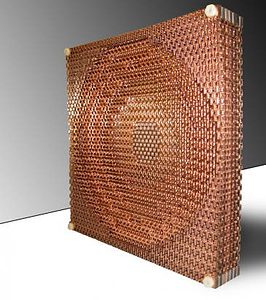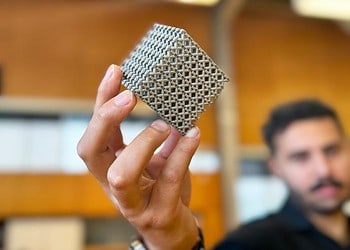Researchers at MIT have created a new metamaterial that they used to fashion a concave lens capable of focusing radio waves with extreme precision. The result lens is extremely lightweight compared to its counterparts developed from conventional materials, and could see promising applications in satellite telecommunications and space exploration of distant stars.
In many ways metamaterials are supernatural, that’s because by definition it is a material artificially engineered by man to have properties that can never be encountered in nature. It’s an extremely exciting field, since you’re basically building new, unique compounds and structures. The most interesting applications of metamaterials we’ve been granted to see comes in the form of invisibility cloaks and what’s commonly referred to as “super lenses” – extremely potent lenses that focus light beyond the range of optical microscopes to image objects at nanoscale detail.
Building the metamaterial lens
The latter is what MIT scientists have been going for with their negative refraction concave lens, which bends electromagnetic waves — in this case, radio waves — in exactly the opposite sense from which a normal concave lens would work. These properties are given off by the structure of the metamaterial, and how individual cells are arranged. In this case, the researchers built a blocky, S-shaped “unit cell” only a few millimeters wide whose shape refracts radio waves in particular directions – 4000 of these were arranged to form the concave negative refraction lens. Each of these cells only bends radio waves slightly, but together they focus the wave.

Isaac Ehrenberg, an MIT graduate student in mechanical engineering, shaped the lens via 3-D printing layer by intricate layer from a polymer solution. He then washed away any residue with a high-pressure water jet and coated each layer with a fine mist of copper to give the lens a conductive surface.
“There’s no solid block of any material in the periodic table which will generate this effect,” Ehrenberg says. “This device refracts radio waves like no other material found in nature.”
In an experiment, two radio antennas were positioned between the metamaterial lens. The resulting energy transmitted through it was found to travel through the lens almost in its entirety, with very little being lost with the metamaterial- significant improvement in energy efficiency when compared with past negative-refraction design. The team also found that radio waves converged in front of the lens at a very specific point, creating a tight, focused beam.
Star Wars’ Death Star laser beam?
As an analogy, Ehrenberg sees the design and functionality of the lens much in the same way as the Death Star’s concave dish that focuses a powerful laser beam to destroy nearby planets in the movie Star Wars. Again George Lucas’ awesome saga offers invaluable inspiration to scientists.
Since it weighs less than a pound, the lens could be used to focus radio waves precisely on molecules to create the same high-resolution images currently produced by very heavy and bulky lenses. Mass is one of the main factors taken into account for space applications, and future space satellites would definitely benefit from this. In addition, Ehrenberg says its fabrication is simple and easily replicated, allowing other scientists to investigate 3-D metamaterial designs.
“You can really fully explore the space of metamaterials,” Ehrenberg says. “There’s a whole other dimension that now people will be able to look into.”
His findings were documented in the Journal of Applied Physics.






